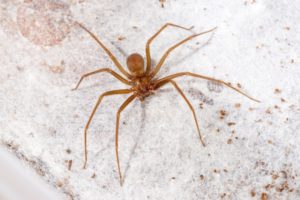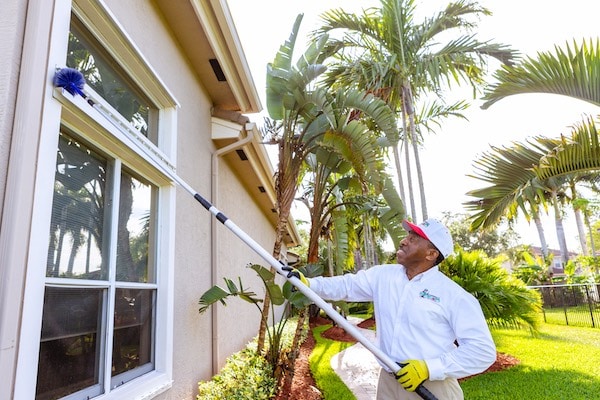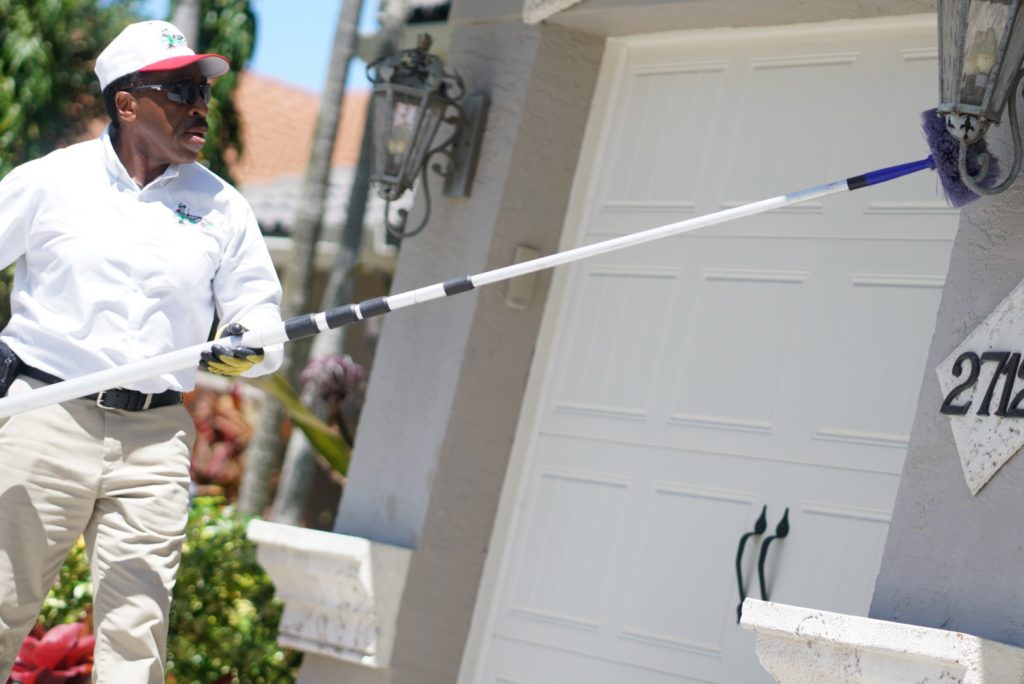Most South Florida residents will notice that while spiders first appear in the summer, their activity peaks between late summer and early fall. Why? Because this coincides with their mating season. So, if you’ve noticed an increased number of spiders, there are probably a few female spiders around getting ready to lay eggs. No matter how you feel about spiders, no one wants to give them a chance to unleash a full-blown infestation.
With over nine hundred species scattered across the state, it’s almost impossible to avoid spiders while living in Florida. However, you can prevent, reduce, or eliminate their presence in and around your home, and avoid some dangerous situations with some basic knowledge.
Here’s a quick and complete guide on spiders in South Florida and how to keep them under control.
What Are South Florida’s Most Common Spiders?

There may be hundreds of spider species in Florida but only a few make up the majority of arachnids you’ll see crawling in and around your home. Some species to watch out for are:
● Common House Spider – As the name suggests, this is one of the most common indoor spiders. They tend to be a brownish color with banded legs, light markings, and two distinct dark stripes on their body.
● Black Widows – With a shiny black body and hourglass marking (usually red) they tend to live outside or in basements and crawlspaces. Bites can be very painful and should be checked by a doctor.
● Brown Recluse – Another venomous spider with a painful bite, these brown arachnids have six eyes instead of the usual eight. They like dark, dry areas.
● Daddy Long Legs – With their fused bodies and noticeably long legs, these spiders are drawn to damp areas such as bathrooms and under kitchen sinks.
● Jumping Spider – If you see a tiny colorful spider leaping across floors, between furniture, and up walls of your home, there’s a good chance it’s a jumping spider.
● Yellow Sac Spider – Aside from their distinctly pale yellow to beige coloring, these spiders have dark-tipped legs, with the two in the front much longer than the others.
● Southern House Spider – Brown or black and covered in a fine fur, these spiders carry violin-like markings on their backs.
Are Spiders Dangerous?
Luckily for us, while some spider bites can result in a trip to the emergency room, most do not bite unless provoked, and most will scurry away at the first sign of human contact. Even some spiders with venomous bites, such as the common house spider or Achaearanea tepidariorum, have a small amount that is effective at killing bugs but causes a mild reaction in humans.
According to Florida’s Department of Agriculture and Consumer Services, the two main types of venomous spiders you need to watch out for are:
● Widow Spiders – With their shiny abdomens, red markings, or pale/lateral stripes, these predominantly black spiders are common in undisturbed outdoor areas. Their bite can cause intense pain, cramping, sweating, nausea, vomit, and hypertension.
● Recluse Spiders – This brown spider with its violin-shaped mark can cause intense pain, itching, ulcers, and tissue death if its bite is left untreated.
Do I Have a Spider Infestation?
Whether indoors or outdoors, the signs of a spider infestation in or around a South Florida home tend to be highly visible. These include numerous spider webs or egg sacs, insects they can feed on, or the spiders themselves crawling about.
How Do I Prevent a Spider Infestation?

Keeping spiders away from your home can be a time-consuming process, but well worth it to stop them from becoming a permanent fixture in your ceilings, attics, windowsills, or other unfrequented areas. Some female spiders can lay upwards of a hundred eggs at a time multiple times per year. That means for every one you keep out of your South Florida home, you’re potentially stopping hundreds more from appearing.
● Seal Your Home – As with most pests, the number one method for keeping them out is to close off all potential entryways. Even the gaps under your doors and windows can be enough for them to crawl through, and this extends to any cracks or openings around electrical wiring, pipes, or cables. Don’t forget your vents, and chimneys, which can still function with a mesh covering.
● Clear Away Nearby Vegetation – From bushes, shrubs, trees, and weeds to flowers and homegrown vegetables, spiders are drawn to cool areas filled with greenery. In South Florida’s tropical climate, they serve as places to hide and hunt. When plants and trees sit against your house and in its perimeter, spiders can easily slip indoors. Be sure to remove any debris as well.
● Clean More Frequently – It doesn’t take much for a spider to find somewhere to settle. Windowsills, the spaces between and behind furniture and appliances, closets, boxes – any untouched space is enough for them to hide. By tidying up frequently, you’ll disturb any stragglers.
● Keep Sources of Food and Water Sealed – Spiders may not eat your food, but they eat the bugs that do. This means that in many cases, a spider problem is secondary to another insect problem that is already taking place in or around the home. Be sure to clean up any pet bowls, feeders, or fallen fruits and vegetables you’ve grown that may attract bugs.
● Natural Repellents – Spiders tend to be very averse to light and strong, sharp scents like citrus, vinegar, peppermint, and eucalyptus. By using the peels, essential oils, or simple kitchen solutions that contain these smells, you can send these unwelcome eight-legged guests on their way. Nightlights also unsettle them.
How Do I Get Rid of Spiders?
Taking sufficient measures to prevent a spider infestation can only be effective if one isn’t already underway. Once you see clear signs that your spider problem is getting out of hand, here are some immediate steps to take to exterminate them:
● Intensive Cleaning – Disturbing areas where spiders have spun their webs and began to lay eggs can send even the worst infestations scurrying fast. However, you need to make sure that they haven’t simply moved from one place in the house to another. Depending on the size of your house, a few days of continuous cleaning could drive a significant number out of the home or away from the perimeter.
● Use Traps – If large-scale cleaning is difficult, or your spiders are in very concentrated or hard-to-reach areas like storage rooms and attics, setting glue traps is another way to get rid of them. This method has the benefit of little to no chemical exposure for those in the home but can take some time to work. It is not recommended when there are more than a few spiders to exterminate.
● Spray Solutions – Aerosols and spidercide sprays are highly effective, but exercise caution when using these substances. Some Florida homeowners may opt for a natural, one-to-one white vinegar and water solution which burns spiders on contact.
● Diatomaceous Earth – Applying this fine sediment powder to areas that spiders frequent can quickly wipe them out as it dries out their bodies while applying microscopic cuts and abrasions. Made from fossils, while it is non-toxic, it should not be inhaled, as it may cause severe respiratory issues. Contact with your skin and eyes should also be avoided.
● Call a Professional – If you’re not too keen on searching for spider nests, handling insect control chemicals, or cleaning up dead bugs, a certified exterminator is your best option. Depending on the size of your issue, they can have it resolved in just a few hours and help protect your home from future infestations.
Professional Spider Extermination Services
Many South Florida residents are no strangers to dealing with spiders and other pests in the home, but some have a much easier time of it than others.
Based out of Coral Springs, Florida, Gregory’s Pest Control has over thirty years of experience protecting families in Broward, Palm Beach, and other South Florida communities from spider infestations. We also have a barrier protection program to eliminate breeding areas and an advanced maintenance service which ensures that one of GPC’s expert personnel return for a checkup every 60 days.
Visit our spider exterminator services page to get a free quote or schedule a complimentary pest evaluation visit.

Paul Gregory
Owner/President of Gregory’s Pest Control
I’m a 2nd generation pest control owner who started working for my father in 1999. I was raised in South Florida and feel blessed to call it home for my entire adult life. As a long-term Florida resident, I recognize the challenges of controlling the many different pests that thrive in our subtropical climate. In particular, I understand how difficult it can be to prevent pests from invading our homes and businesses. By helping families solve their pest problems so they can live safer, more comfortable lives, I feel I am also meeting my family’s commitment to help our community. When I’m not out fighting pests, you can find me on the golf course or out on a soccer field where I have been fortunate enough to coach soccer to kids of all ages for the past 20 years.





